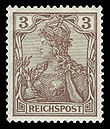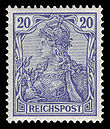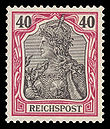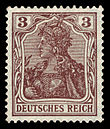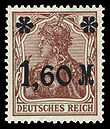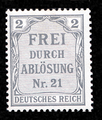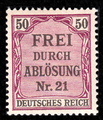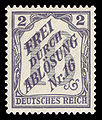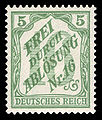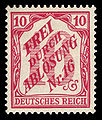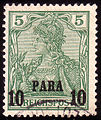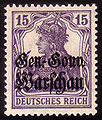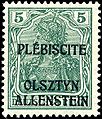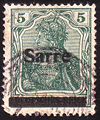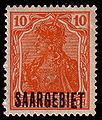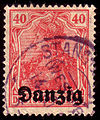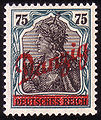Germania (postage stamp)
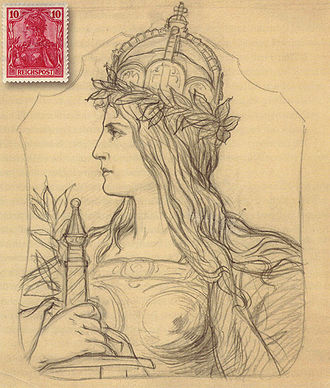
The Germania stamp series are postage stamp issues of the German Reich with the portrait Germanias that in the years 1900 bis 1922 were used. These stamp series are among the most famous and long-lived in Germany and are a popular collecting area among philatelists .
In some cases, the Germania series also includes the additional mark values Representative Representations of the German Empire , although neither shape, motif and stamp artist are identical. The only thing that connects both series with each other is the year of issue and the period of use.
Issue occasion
The Germania stamp series comprises a total of 60 values (without subtypes) in different versions and was the fourth permanent series of the Deutsche Reichspost to solve the issues "Breast shields" (MiNo. 1–30), "Pfennige" (numbers or imperial eagle, MiNo. 31–36) and "Pfennig" (same drawing with changed value, MiNr. 39-44) and "Krone - Adler" (MiNr. 45-52) from. The neutral pattern of Germania was chosen so as not to complicate the takeover of the Bavarian and Wuerttemberg postal services through the depiction of the emperor and to represent a contrast to the previous series. The designs for the stamp series, which were even adopted by Kaiser Wilhelm II, came from Paul Eduard Waldraff (1870–1917). In retrospect, he wrote about the issue process:
“Starting from the door, the Most High Art Connoisseur paces down the easels at a barely slowed pace, followed by his adjutant. When he got back to the door, the emperor turned around, went straight across the hall towards the Germania and spoke the decisive and only word 'Die' with a finger pointing at it. He was outside. "
The model for the portrait of Germania was the actress Anna Führing .
Executions
There are numerous versions of the Germania brands. The inscription was initially Reichspost , later the German Empire . Numerous overprints were made for the foreign post offices in China, Morocco and Turkey, the areas occupied during World War I , but also for the Bavarian postal area , which was united with the German after World War I, the Allenstein and Marienwerder voting areas , for the Saar area , Gdansk and Memelland as well as for the production of charity stamps .
German Empire: Germania Kehrdruck from booklet sheet 14/15
There are two variants of the image design: For most values, Germania is shown in front of a horizontally hatched background, but for some values in front of a non-hatched (white) background.
As a definitive series, the Germania was also used on postal stationery as a value stamp for postcards , card letters and pneumatic tube envelopes . The special postcard at the turn of the century was officially sold on December 28, 1899, but the earliest use dates back to December 24, 1899.
Specimen
The stamps also appear with the imprint "Specimen" (as an official orientation model, mostly in the new edition, e.g. for presentation to the Universal Postal Union ).
Imitations
For the Kinderpost game , there were imitations of the Germania brand, the lettering here was Kinderpost for some manufacturers (for others they corresponded to the original stamps with one size difference).

Fakes
During the First World War , the British forged the values of 10 Pfennig and 15 Pfennig (Michel No. 86 PFä and 101 PFä). The fakes are u. a. recognizable by their chalk white paper and the too narrow lines of the watermark.
In 1902, several postage stamp forgeries were carried out to the detriment of the post office, such as the forgery of the 10 Pfennig stamp known as the “Chemnitz forgery” (Michel number 71) and the so-called “Deistel forgery”. There were further forgeries in 1916 in Cologne and Hanover. The overprint stamps from 1921 were also forged (Mi.-Nr. 154, 156, 157).
List of brands
German Empire
Inscription: Reichspost
A total of ten postage stamps appeared on January 1, 1900 with the inscription Reichspost . On April 13, 1901, as a so-called Vineta provisional solution, the value of 5 Pfennig (Michel number 55) was halved and sold with a purple imprint for 3 Pfennig. All stamps were valid up to and including December 31, 1902.
| image | Value in pennies | colour | issue date | Michel no. |
|---|---|---|---|---|
| 2 | light to dark blue gray | 4th July 1900 | 53 | |
| 3 | olive brown | February 1900 | 54 | |
| 5 | light to dark green | March 1900 | 55 | |
| 10 | carmine pink, red | December 30, 1899 | 56 | |
| 20th | ... | January 8, 1900 | 57 | |
| 25th | ... | March 10, 1900 | 58 | |
| 30th | ... | December 27, 1899 | 59 | |
| 40 | ... | December 27, 1899 | 60 | |
| 50 | ... | December 20, 1899 | 61 | |
| 80 | ... | January 1, 1900 | 62 | |
| 3 | green (3 to 5 Pfennig halved stamp, Vineta provisional , Mi-No. 55 halved with purple overprint) | April 13, 1901 | (formerly 67) now: usage variant "A I" |
Inscription: German Empire
The stamps that appeared from April 1, 1902 bore the inscription Deutsches Reich . In order to be able to finance the world war, various postal charges were increased by means of the Reich tax from 1916; this led to the issuance of additional values (2½ pfennig; 7½ pfennig; 15 pfennig) and to the renewed issuance of a stamp for 2 pfennigs, each with a non-hatched background. The stamps were valid until October 31, 1922 due to the onset of inflation . The last new edition appeared on April 2, 1922.
The four stamps published in August 1921 (Michel numbers 154 to 157) were withdrawn from counter sales on January 20, 1922 and only used in the office. Post customers were no longer allowed to use these stamps after the specified date.
| image | Value in pennies | colour | issue date | Michel no. |
|---|---|---|---|---|
| 2 | ... | April 1, 1902 | 68 | |
| ... | ... | April 1, 1902 | ... | |
| 80 | ... | April 1, 1902 | 77 | |
| 2 | ... | 1905/1911 | 83 | |
| 3 | ... | October 21, 1905 1911 |
84 | |
| ... | ... | 1905/1911 | ... | |
| 80 | ... | 1905/1911 | 93 | |
| 2.5 | ... | August 1, 1916 / May 1917 | 98 | |
| ... | ... | August 1, 1916 / May 1917 | 99 | |
| ... | ... | August 1, 1916 / May 1917 | 100 | |
| ... | ... | August 1, 1916 / May 1917 | 101 | |
| ... | ... | August 1, 1916 / May 1917 | 102 | |
| ... | ... | August 1, 1916 / May 1917 | 103 | |
| ... | ... | August 1, 1916 / May 1917 | 104 | |
| 10 + 5 | War Disabled Aid Michel 86 with overprint | May 1, 1919 | 105 | |
| 15 + 5 | War Disabled Aid Michel 101 with overprint | May 1, 1919 | 106 | |
| ... | ... | January 1920 | 140 | |
| 10 | yellowish to reddish orange | September 2, 1920 | 141 | |
| ... | ... with print | January 1920 | 153 | |
| 1.60 marks | ... with print | August 1921 | 154 | |
| 3 marks | ... with print | August 1921 | 155 | |
| 5 marks | ... with a green print | August 1921 | 156 | |
| 10 marks | ... with print | August 1921 | 157 | |
| 75 | lively purple carmine | April 2, 1922 | 197 | |
| 1 1/4 | medium brownish, red, dark purple | April 2, 1922 | 198 |
Stamp booklet
In addition to the individual stamps, stamp booklets issued by the Post in a total of 15 series came into circulation from 1910 to 1921 , which, in addition to the postage stamps, also contained a cover sheet and several interleaves, mostly printed with advertising.
Bavaria
In Bavaria, which still had its own post office shelf until mid-1920 , Germania stamps with the imprint "Free State of Bavaria" were sold from May 1919 in the value levels 2½, 3, 5, 7½, 10, 15, 20, 25, 35, 40, 75 and 80 pfennigs issued (Mi.-No. 136 to 147).
Official stamps
The official stamps issued in Prussia in 1903 and in Baden in 1905 were used to determine the actual postage amounts for official mail within the two countries in order to reset a lump sum to be paid to the Reichspost .
The stamp frame of the Germania definitive stamp series was used to design the stamp.
In the case of the issue for Prussia , the stamp frame read Frei by redemption no.21 . The eight stamps were only valid within 1903.
In the issue for Baden , the stamp frame read Frei by Replacement No. 16 in oblique font. The six stamps were only valid within 1905.
Further use in the German post offices abroad, in the occupied areas, etc.
German foreign post offices
The Germania series appeared with overprints, some hand stamps (China), mostly letterpress overprints, like this: "Deutsche Post in ..."
... China , from November 24, 1900
... Turkey , from October 10, 1900
In the German colonies , a uniform brand image with the imperial yacht was used instead of the Germania brands .
German occupation issues of the First World War
National post in Belgium (for the General Government of Belgium ), from October 1, 1914
West stage area (occupied areas in north-eastern France), from December 1, 1916
Post area Commander-in-Chief East ( Ober Ost ), from January 15, 1916
Postcard from Libau to Berlin dated December 4, 1917. Post area Commander in Chief East
German voting areas and subsequent uses
- Libau (Liepāja). In the city, which was under the administration of Latvia , which had become independent from January 2, 1919 , the postal traffic was initially taken care of by the remaining German 8th Army , the existing Germania stamps in small numbers with an oblique purple-blue or red hand stamp imprint " LIBAU ”and brought it into circulation from January 2, 1919. This was forbidden by the Reich Post Office on January 11, 1919, but the existing stocks were allowed to be used up.
- Upper Silesia (edition of the French occupation authority Commission Interalliée de Gouvernement et de Plébiscite de Haute-Silésie , so-called Opole emergency edition ) from February 1920, with hand stamp overprint "CIHS" in bridge on circle
- Marienwerder , with three-line imprint "Commission Interalliée Marienwerder", partly with imprint of a new value. There are countless variations of the prints made by a local printer.
- Allenstein , with black three-line imprint "PLÉBISCITE OLSZTYN ALLENSTEIN" (from April 3, 1920) or imprint in a vertical oval (from May 1920)
- Saar area , imprint initially “Sarre”, later “SAARGEBIET”, partly in decorative script with the new Saar coat of arms
- Memel region (League of Nations mandate)
- Danzig (Free City). The first overprints for Danzig were made by the Reichsdruckerei Berlin, later (from August 10, 1920) by the Julius Sauer printing company in Danzig. The large number of different, mostly colored imprints is remarkable.
- Poland (crossed-out overprint Gen.-Gouv. Warsaw and further overprint Poczta Polska, partly with additional value overprint, Michel no. 6–16, as well as overprint Poczta Polska on Germania stamps of the German Empire, Michel no. 130-134 ("First Posener Aushilfsausgabe"), and stamps of the German Reich with new value overprint, Mi.-Nr. 135 and 136, on values 2 and 7½ Pfennig, "Second Posener Aushilfsausgabe", this issue (edition: 20,000 pieces each) is Noteworthy in that only large new numerals - 5 and 10 - are printed (in letterpress and in the autograph process ), but no further information), further Polish local editions with local overprints in Alexandrowo, Baranów, Błonie, Brzeziny, Ciechocinek, Grodzisk, Izbica , Kalisz, Łęczyca, Łowicz, Łuków, Ostrolęka, Ostrów, Ozorków, Plońsk, Poddębice, Pultusk, Sieradz, Skiernewice, Włocławek and Zduńska Wola.
Web links
- Germania brands working group
- Germania collection
- Collection mainly concerned with the maps of the century from Germania
- Online catalog with a foreword and reviews
- www.germaniamarken.de
literature
-
German Society for Postal and Telecommunications History (DGPT) as publisher:
- Heinz Hillmer: A picture went around the world - 75 years of the Germania postage stamp. In: Archive for German Postal History Issue 1/1975, ISSN 0003-8989 , pp. 96-106
- Andreas Hahn: Simple and moving - the post horn series and the earlier stamp design of the Deutsche Bundespost , in Das Archiv , 1/2009, p. 22 ff
-
Michel catalog
- Germany special
- Letters catalog Germany
- Postal stationery catalog Germany
- Handbook Germania-Marken, compiled and published by Arbeitsgemeinschaft Germania-Marken e. V. in the BDPh e. V. , loose leaf, 1988 ff (not completed)
- Hans Friedrich: The Germania brands of the German Empire - a study on the structure of a special collection of Germania brands in the Reich territory . In: Philately and Postal History, Ed .: Foundation for the Promotion of Philately and Postal History e. V. , Bonn-Bad Godesberg, No. 29; 1974
- Hans Friedrich: The Germania brands of the German Empire . In: Handbuch Germania-Marken, Register 25, S. 010.901.01-24
- Michael Jäschke-Lantelme: 100 Years of Germania , Dessau 1999, 339 pp.
-
German Postage Stamp Review
- Andreas Hahn: Designs of the Germania series. (Continuation article) from issue No. 9/2002, p. 15 f
- Edition 10/1990
Individual evidence
- ^ Deutsche Post AG, The Art Advisory Board .
- ↑ Michel postal stationery catalog 1999, p. 121.
- ↑ See e.g. B. Michel catalog Europe East, introduction p. 11.
- ↑ Handbook Germania Brands, Register 26, Pages 010.950.01-010.950.04, Author: Dr. T. Reimer and M. Althen, with addendum.
- ↑ To No. 157 G. Zenker in INFLA -berichte 147/1989 p. 33, also in Germania-Handbuch Register 18 p. 010.012.24.100a-101.
- ↑ Gerald Schwarz: Germania-Markenheftchen des Deutschen Reiches (1997), in: Handbuch Germania-Marken, Register 19, pages 010.050.01 to 010.05095.
- ↑ F. Mörbel: The Germania brand booklets and their sheets, Federal Working Group on roller brands, brand booklets, machine brands in the BdPh 2010.
- ↑ Handbook Germania Brands Register 7, page 010.001.01
- ↑ Michel Germany Special Catalog 1983/84, p. 981 f.
- ↑ Illustration of an overprint mark issued for Libau .
- ↑ Gunnar Gruber: Die Oppelner emergency editions, BPP series of publications Vol. 5, 2nd edition, Radolfzell 2013.
- ↑ Illustration of stamps of the "Oppelner Notausgabe" .
- ↑ In-depth study of the overprint types by Walter Bauer (1995) in the Germania-Marken Register 35 manual, pages 042.900.01 to 042.900.205.
- ↑ Stefan Petriuk: 1st auxiliary edition for Posen from August 5, 1919, in: Circular 151 of the Working Group on German Eastern Regions, page 1/2 (September 1996).
- ↑ Michel catalog Europa-Ost 1979, p. 262.
- ^ Website with a reproduction of a local edition of the city, probably reprint .










